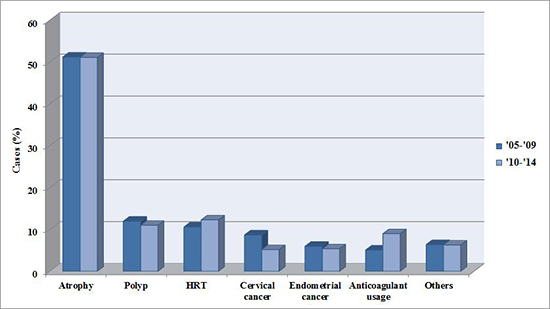1. Breijer MC, Mol BW. Transvaginal ultrasound measurement of the endometrium remains the first line test for investigating postmenopausal bleeding but integration of patient characteristics into testing may further improve diagnostic algorithms. BJOG. 2016; 123:447.
2. Salman MC, Bozdag G, Dogan S, Yuce K. Role of postmenopausal bleeding pattern and women’s age in the prediction of endometrial cancer. Aust N Z J Obstet Gynaecol. 2013; 53:484–488.
3. Wong AS, Lao TT, Cheung CW, Yeung SW, Fan HL, Ng PS, Yuen PM, Sahota DS. Reappraisal of endometrial thickness for the detection of endometrial cancer in postmenopausal bleeding: a retrospective cohort study. BJOG. 2016; 123:439–446.
4. Dueholm M, Marinovskij E, Hansen ES, Møller C, Ørtoft G. Diagnostic methods for fast-track identification of endometrial cancer in women with postmenopausal bleeding and endometrial thickness greater than 5 mm. Menopause. 2015; 22:616–626.
5. Smith PP, O’Connor S, Gupta J, Clark TJ. Recurrent postmenopausal bleeding: a prospective cohort study. J Minim Invasive Gynecol. 2014; 21:799–803.
6. Izetbegovic S, Stojkanovic G, Ribic N, Mehmedbasic E. Features of postmenopausal uterine haemorrhage. Med Arh. 2013; 67:431–434.
7. Loiacono RM, Trojano G, Del Gaudio N, Kardhashi A, Deliso MA, Falco G, Sforza R, Laera AF, Galise I, Trojano V. Hysteroscopy as a valid tool for endometrial pathology in patients with postmenopausal bleeding or asymptomatic patients with a thickened endometrium: hysteroscopic and histological results. Gynecol Obstet Invest. 2015; 79:210–216.
8. Dueholm M, Hjorth IM, Secher P, Jørgensen A, Ørtoft G. Structured hysteroscopic evaluation of endometrium in women with postmenopausal bleeding. J Minim Invasive Gynecol. 2015; 22:1215–1224.
9. Breijer MC, van Hanegem N, Visser NC, Verheijen RH, Mol BW, Pijnenborg JM, Opmeer BC, Timmermans A. Does probability guided hysteroscopy reduce costs in women investigated for postmenopausal bleeding. ScientificWorldJournal. 2015; 2015:605312.
10. Cavkaytar S, Kokanali MK, Ceran U, Topcu HO, Sirvan L, Doganay M. Roles of sonography and hysteroscopy in the detection of premalignant and malignant polyps in women presenting with postmenopausal bleeding and thickened endometrium. Asian Pac J Cancer Prev. 2014; 15:5355–5358.
11. Park Y, Vongdala C, Kim J, Ki M. Changing trends in the incidence (1999–2011) and mortality (1983–2013) of cervical cancer in the Republic of Korea. Epidemiol Health. 2015; 37:e2015024.
12. Jung KW, Won YJ, Kong HJ, Oh CM, Cho H, Lee DH, Lee KH. Cancer statistics in Korea: incidence, mortality, survival, and prevalence in 2012. Cancer Res Treat. 2015; 47:127–141.
13. Lim MC, Moon EK, Shin A, Jung KW, Won YJ, Seo SS, Kang S, Kim JW, Kim JY, Park SY. Incidence of cervical, endometrial, and ovarian cancer in Korea, 1999–2010. J Gynecol Oncol. 2013; 24:298–302.
14. Shin MH, Oh HK, Ahn YO. Ten year trend of cancer incidence in Seoul, Korea: 1993--2002. J Prev Med Public Health. 2008; 41:92–99.
15. Berek JS, Novak E. Berek & Novak's Gynecology. 15th ed. Philadelphia, PA: Wolters Kluwer Health/Lippincott Williams & Wilkins;2012.
16. Fritz MA, Speroff L. Clinical Gynecologic Endocrinology and Infertility. 8th ed. Philadelphia, PA: Wolters Kluwer Health/Lippincott Williams & Wilkins;2011.
17. Moodley M, Roberts C. Clinical pathway for the evaluation of postmenopausal bleeding with an emphasis on endometrial cancer detection. J Obstet Gynaecol. 2004; 24:736–741.
18. Dueholm M, Hjorth IM, Secher P, Jørgensen A, Ørtoft G. Reproducibility of endometrial pathologic findings obtained on hysteroscopy, transvaginal sonography, and gel infusion sonography in women with postmenopausal bleeding. J Minim Invasive Gynecol. 2015; 22:1036–1044.
19. Oh CM, Jung KW, Won YJ, Shin A, Kong HJ, Jun JK, Park SY. Trends in the incidence of in situ and invasive cervical cancer by age group and histological type in Korea from 1993 to 2009. PLoS One. 2013; 8:e72012.
20. Kyvernitakis I, Kostev K, Hars O, Albert US, Hadji P. Discontinuation rates of menopausal hormone therapy among postmenopausal women in the post-WHI study era. Climacteric. 2015; 18:737–742.
21. Kim JY, Sang JH, Park HM. The change of hormone therapy in postmenopausal women in Korea before and after women’s health initiative study: 2000–2009. Korean J Obstet Gynecol. 2010; 53:1110–1117.
22. Cummings SR, Ettinger B, Delmas PD, Kenemans P, Stathopoulos V, Verweij P, Mol-Arts M, Kloosterboer L, Mosca L, Christiansen C, et al. The effects of tibolone in older postmenopausal women. N Engl J Med. 2008; 359:697–708.
23. Hammar ML, van de Weijer P, Franke HR, Pornel B, von Mauw EM, Nijland EA; TOTAL Study Investigators Group. Tibolone and low-dose continuous combined hormone treatment: vaginal bleeding pattern, efficacy and tolerability. BJOG. 2007; 114:1522–1529.






 PDF
PDF ePub
ePub Citation
Citation Print
Print






 XML Download
XML Download